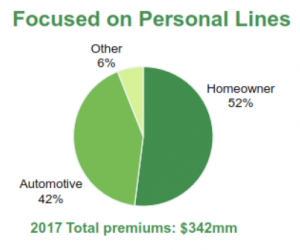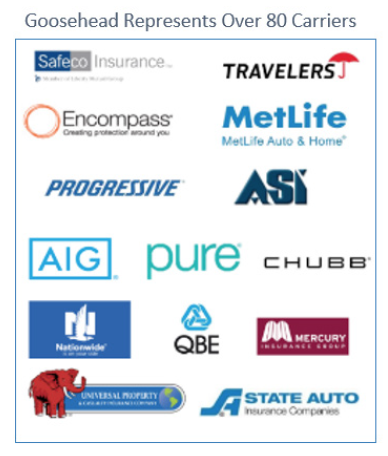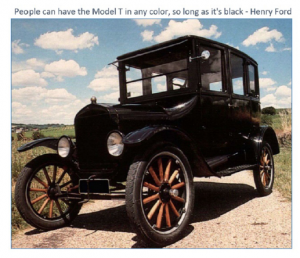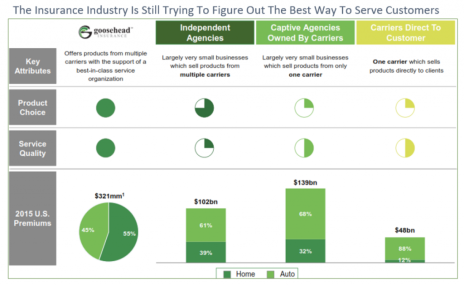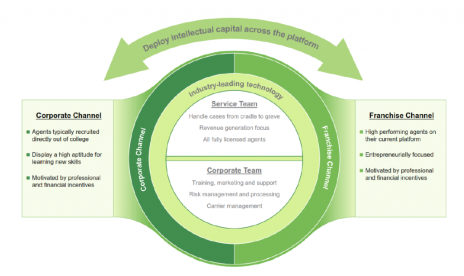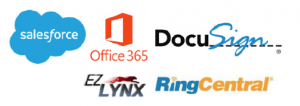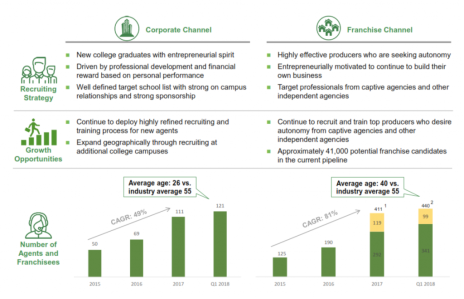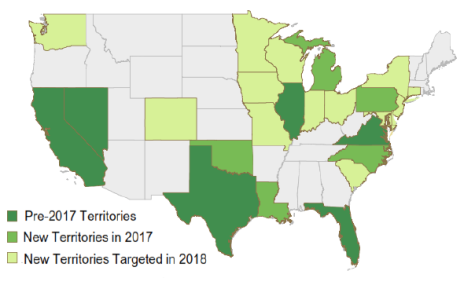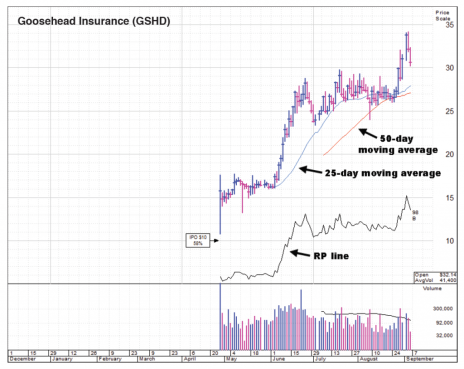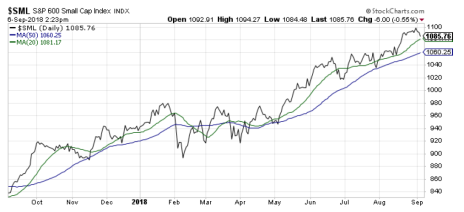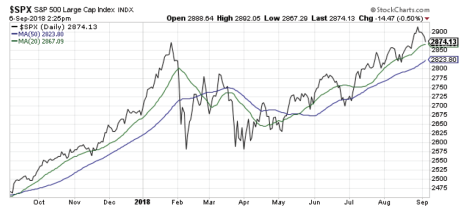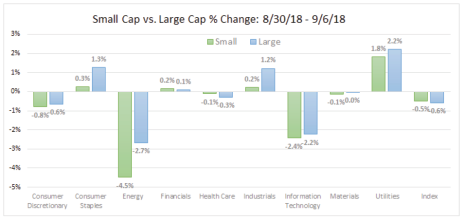Today’s Cabot Small-Cap Confidential addition isn’t a cloud-based software provider. But it is a perfect example of what I’ve been talking about – a company in an established industry that’s shaking things up largely because cloud-based technologies are at the center of its DNA. The company’s platform is helping it grow roughly 10 times faster than its industry average, while delivering profits.
It’s an exciting story that I’ve been looking forward to sharing with you. Enjoy!
Cabot Small Cap Confidential 232
[premium_html_toc post_id="158510"]
THE BIG IDEA
Warren Buffett is widely considered one of the best investors in history. Over the last 53 years Berkshire Hathaway’s (BRK/A) per-share market value has grown at an average annual rate of 21%. That works out to 10% better, every year, than the S&P 500 (including dividends).
One of the reasons for this sustained outperformance is that Buffett bought insurance companies. His love of insurance first materialized with the acquisition of National Indemnity in 1967. Over the years Buffett has purchased more than 10 companies that offer and underwrite various forms of insurance. Today, 70% of Berkshire’s $712 billion in listed assets were in the Insurance and Other category.
Berkshire’s insurance businesses are massive and sophisticated, way beyond the scope of anything we’ll ever get into. But Berkshire’s success, due in no small part to the regular collection of insurance premiums, can serve as a valuable lesson for investors.
And the lesson is this: year in and year out, people will always buy insurance for their cars, houses, boats, health, and even to insure their insurance policies! Insurance is just a fact of life, a regular bill for most people. While it’s a relatively slow-growth industry overall, consistent market demand makes insurance big business. Personal lines insurance alone is a massive $300 billion industry!
Yet oddly, from the consumer’s perspective, there doesn’t appear to have been a lot of innovation in this industry. Sure, the GEICO cavemen are funny and create terrific branding for selling car insurance direct-to-consumer (DTC). And Peyton Manning made some good commercials for Nationwide. But these are marketing initiatives, not exactly differentiating business models.
In general, when you need a policy you do the same thing you did decades ago: call around and talk to agents, or a direct-to-consumer carrier like GEICO. When you need to buy another type of insurance you call again. Every now and then you file a claim.
Problems usually arise when you need some form of insurance that your agent can’t provide, the policy you need costs too much, or you need to file a claim and it takes a long time to sort everything out. In these situations, people often devote obscene amounts of time to dealing with insurance agents, trying to get the coverage they need or the reimbursement they expected. All too often insurance agents are more interested in selling new policies than servicing the policies they already sold.
In short, this industry is ripe for disruption. And in one corner of the personal lines insurance market a small company is doing just that. It’s giving people the widest choice of insurance options possible, at reasonable prices, while delivering exceptional service.
The company’s secret lies in a powerful cloud-based technology platform. As in so many industries, cloud-based technology has the potential to transform the personal lines insurance market. And this company is showing how.
The short version is that the company has centralized customer service activities on the best cloud-based software platform out there, Salesforce.com, then integrated solutions to handle specific activities, like call center, document signing and policy comparison shopping.
Consumers get a dedicated customer service team powered by the best technology available. That translates into short wait times and no more bouncing from agent to agent because nobody knows how to help.
Insurance agents get to do what they love to do and what they get paid to do, which is go out and sell the ideal insurance policy to the person that needs it. They can do this with the confidence that sales, marketing and training activities are supported by a purpose-built platform, while customer service and renewal activities are directed to service agents who are better equipped to help.
This new business model sounds compelling in concept, but it really starts to sound good when you see the numbers. Because while the personal lines insurance market is growing in the low single digits, today’s new addition has been growing by more than 30% for the last three years. And growth is expected to accelerate to 40% this year!
This is a potentially massive idea in a corner of the world where growth investors don’t typically venture. But we’re jumping in today because when an upstart company disrupts the status quo in a huge industry, good things can happen for those that get in early.
THE COMPANY/PRODUCT
Goosehead Insurance (GSHD) is a unique, rapid-growth player in the insurance industry that is building something entirely new – an independent personal lines insurance sales and support platform. This platform is being deployed on a national scale through a hybrid corporate and franchise distribution model.
Goosehead is the only publicly-traded insurance broker of its kind out there. It’s growing quickly, while maintaining profitability, by selling auto, homeowners’, and other personal lines (boat, umbrella, etc.) insurance to individuals across the U.S. Many customers begin with a homeowners’ policy, which is a relatively sticky business with high renewal rates, then are upsold to auto and other policies. The company does not underwrite any policies and therefore has zero underwriting risk.
Goosehead is based in Texas, went public in April 2018 and has a market cap of $1.2 billion. In 2017, revenue grew by 36% to $42.7 million and EPS grew by 85% to $0.24. In 2018 revenue is expected to grow by 40% while EPS is expected to grow by 30% to $0.27. That is insane growth in an industry where low-single-digit growth is the norm.
The personal lines market is very fragmented, yet places roughly $300 billion of premiums each year. This large and fragmented market hasn’t seen a lot of innovation over the years, making it a veritable playground for an innovative company like Goosehead. Better yet, the personal lines market enjoys strong pricing power; auto insurance prices have been going up around 9% a year and homeowners’ insurance prices have been ticking up at a modest rate too.
Part of the special sauce is that Goosehead has relationships with around 80 insurance carriers, so clients have a wide variety of choice and Goosehead agents can offer the best policies for clients’ needs. Management believes this wide representation helps the company deliver broader insurance coverage at a lower price point than the competition.
The other ingredient in the special sauce is Goosehead’s unique platform, which I’ll discuss in more detail in a minute.
A Crash Course in Personal Lines Insurance
In the personal lines insurance business revenue is generated through commissions, which are calculated as a percentage of the total insurance premium paid by the client. Fees and other related services also contribute to revenue.
On average, personal lines premiums have gone up by an average of 3.3% a year for the last decade, but pricing is cyclical, depending on the underwriting capacity of the insurance industry, economic conditions and trends in certain markets. For example, when bodily injury costs go up so do auto policy premiums. When hurricanes hit the northeast, homeowners’ premiums in that region go up.
Historically there have been three types of business models for selling personal lines products. Goosehead has introduced a fourth (see table below):
Independent Agencies: Businesses that offer products from a multitude of insurance carriers. They offer good choices but relatively poor service because few have invested in integrated platforms and/or internal service departments, instead relying on customer service reps (CSRs). These players make up around 30% of the market. Most big independents focus on commercial lines, leaving smaller independents competing for personal lines. These businesses are relatively easy to get up and running due to low start-up costs and a variable cost structure.
Captive Agencies: Businesses in which agents sell products from only one carrier. Product choice is poor (you have just one!), but service is OK. Captive agencies make up around 50% of the market. Big captive agencies include Farmers, Allstate and State Farm.
Carriers Direct-to-Consumer: Carriers market and sell insurance products directly to clients over the phone or internet. This approach has mostly worked well for auto insurance only. Industry leaders are Progressive and GEICO (owned by Berkshire), and this type of business holds about 20% (and growing) market share.
The Goosehead Independent Agency Model: The problem (at least from Goosehead’s perspective) has been that none of these approaches serve customers in an outstanding way. Customers, usually unknowingly, are forced to choose between either product choice or service quality. In the mind of a consumer this might not be a big deal if all that’s needed is an auto insurance policy. But as other coverages become necessary, options and service, along with price, become bigger factors.
This is where the fourth, and newest, type of insurance business comes into play, and it’s the one being pioneered by Goosehead. The model is a twist on the Independent Agency model, which is made better by extensive use of cloud-based technology, which allows for separation of sales and support functions. Goosehead’s pitch is that its model offers great choice, great service, AND great pricing! What’s not to like?
A Unique Platform For Selling Insurance
To achieve its vision of offering superior insurance at the best price in a timely manner, Goosehead has developed an innovative platform that it hopes to deliver on a national scale.
The platform has three key differentiators: (1) separation of sales and service functions, (2), extensive use of cloud-based technology, and (3) a hybrid sales model deployed through both a Corporate Agent Channel and a Franchise Agent Channel.
By separating sales and service functions Goosehead’s platform drives better customer experiences. Wait times are usually under one minute because service agents are 100% focused on service. They are empowered with the tools and training to resolve issues and can handle cases from cradle to grave. Service agents are also licensed, so they can add cars and new drivers to policies, or even upsell the client to new policies.
Meanwhile, sales agents (in both the Corporate and Franchise Channels) are totally focused on sales and marketing activities. This is very different from a traditional insurance company where agents also face the daily grind of servicing existing policies and pursuing renewals. This dual-focus can distract them from acquiring new clients, especially since as the volume of existing policies grows they have less time to go out and sell new ones. Instead, Goosehead agents spend more time working through Goosehead’s marketing strategies, which directs attention to financial services providers in an agent’s community. This approach also helps keeps client acquisition costs down and success rates high.
All activities are supported by the purpose-built platform, which is powered by Salesforce. The platform relies on plug-and-play cloud-based technologies to streamline operations and provide a 360-degree view of customer activity, reporting and document delivery. The platform also helps ensure quality control.
Just a few of the technologies used include RingCentral (cloud-based telephony), Microsoft Office 365, DocuSign (e-signature capabilities) and EZLynx (comparative quoting tool).
This platform can be a very attractive asset when recruiting new agents, depending on where they are at in their careers. Because most corporate agents are recruited directly out of college, and most franchises are run by entrepreneurially-minded people, grasping the platform technologies comes relatively easily.
The effectiveness of this platform shows up in Goosehead’s metrics. It had a customer retention rate of 88% and a net promoter score (NPS) of 87 in 2017. That NPS is nearly twice that of the property and casualty insurance industry and better than many leading consumer brands, including Amazon and Apple.
The punchline is that Goosehead’s modern platform approach to selling insurance and supporting customers is powering rapid growth. Average annual organic revenue growth was 35% over the past three years. That is far and away the fastest growth in this industry, and it’s expected to accelerate to over 40% for the next couple of years.
A Two-Pronged Sales Growth Strategy
Another way Goosehead is different from most insurance companies is that it has two distribution channels: a Corporate Channel and a Franchise Channel. Both segments are managed by Goosehead’s headquarters in Westlake, Texas, which also oversees and integrates other business functions, including recruiting, technology, service, referral networks, quality control, legal, finance, etc.
The Corporate Channel
The Corporate Channel generated 60% of revenue in 2017 and includes company-owned and financed operations with employees that are hired, trained and managed by Goosehead. Corporate agents are recruited directly out of college, which means Goosehead’s average agent age is 26, well below the industry average of 55. The company’s recruitment efforts focus on candidates with a high aptitude for learning new skills, that display willingness and talent to learn new skills, that work well in a team environment, and that are motivated by financial and professional incentives. Corporate agents get 40% of new business commissions and 15% of renewal commissions (for which they do very little work).
Extensive training gives these recruits the proper tools, training and licenses to go out and crush it. And they do! Management says average Corporate Channel agent compensation is around $75K after two years and almost $160K after more than three years. Clearly, compensation is directly tied to productivity. Goosehead says Corporate agents with over three years tenure are more than 3.5 times as productive as the industry average of $41K. Those with under two years are still almost twice as productive.
The Franchise Channel
The Franchise Channel generated 40% of revenue in 2017 and includes Franchisee operations managed by Franchisees, which have a contractual relationship to use Goosehead’s processes, systems, and back office support team to sell insurance and manage their business.
Most franchise agents have been recruited from exclusive agency companies, including State Farm and Allstate. Many have had a hard time giving clients the policies they want since the agent could only represent one company. Or their attention became too divided because they had so much business they had a hard time devoting time to selling since they were constantly servicing existing policies.
Franchise agents earn 80% commissions on new business and 50% commissions on renewals. With access to Goosehead’s service capabilities, training programs and 80 carrier relationships the company expects to make Franchise agents much more productive than they otherwise would have been. The early evidence suggests it’s working; Franchise Channel agents bring in around $50K after two years and over $64 after three years or more. In both cases, sales with Goosehead are well above the industry average of $41K.
History—From Texas Startup to National Agency
In 2003 Mark Jones, a Senior Partner at Bain & Co., and his wife Robyn, a real estate investor, launched The Goosehead Insurance Agency. The idea came from a personal need for the couple to solve their own issues insuring their real estate business. It then morphed into a bigger effort to provide true concierge client service and terrific value, while also providing the power of choice from the top rated national and regional insurance carriers.
The company was started outside of Dallas, Texas, with corporate agents selling policies. It continues to grow its corporate agency force and had 148 agents at the end of Q2 2018, mostly in Texas and Illinois.
Much of the future growth is expected to come from the franchise model that Goosehead developed and rolled out in 2012. Franchises enjoy the same comprehensive service support as corporate agents. The company now has 385 franchises, most of which are in California, Texas, Florida and Illinois. Another hundred or so are in the implementation process.
Management says it has a pipeline of over 40,000 franchise leads out of a pool of nearly 400,000 identified U.S. insurance agents. These leads are being evaluated by a Franchise recruiting team of roughly 25 people. As leads move through the pipeline new territories are opening, especially in the northeast and upper Midwest (see map).
The Business Model
Goosehead Insurance sells and services personal lines insurance to clients in the U.S. using a platform approach where centralized service agents are empowered with cloud-based technologies and sales agents focus on marketing and sales activities.
The company generates most of its revenue through commissions on new business (average commission rate of 16% in 2017) and renewal business (average commission rate of 14% in 2017). It also generates some revenue through initial franchise fees ($40,000 in Texas, $25,000 everywhere else) and contingent commissions (contractual payments from carriers contingent upon growth and profitability of business placed with carrier).
Roughly 60% of business comes through referrals (real estate closings, etc.). Many customers begin with a homeowners’ policy, then are upsold to auto and other policies. Goosehead represents over 80 insurance companies that underwrite the personal lines. It does not take any insurance underwriting risk.
The company sells through two segments, the Corporate Channel (60% of revenue) and Franchise Channel (40% of revenue). Service agents are also able to sell (typically upsells) and generated 10% of new business revenue in 2017 (falls under Corporate Channel). Franchisees pay a royalty fee of 20% on new business revenue and 50% on renewal revenue. Corporate agents are paid a salary and Goosehead retains 60% of new business and 85% of renewal business. Profit margins are higher in the Franchise Segment due to a lower expense base.
The business is primarily driven by growth in the number of franchise and corporate agents, their respective production, and the ability of the service agents to retain customer (plus upsell). Provided Goosehead adds agents as quickly as it expects, that these agents perform above industry averages as they have, and that the service agents continue to do their job, rapid top-line growth should continue while economies of scale should drive profit growth.
The Bottom Line
In 2017 revenue grew by 36% to $42.7 million and EPS grew by 85% to $0.24. Revenue in the Corporate Channel (60% of total) grew by 26% while revenue in the Franchise Channel (40% of total) grew by 53%. Goosehead has roughly 13.5 million public (Class A) shares outstanding, which is equal to just under 40% of the company. This figure is used to calculate earnings per share, while all shares are included in the company’s market cap calculation.
In Q2 2018 (reported August 7) revenue grew 36% to $14.8 million while EPS fell to -$0.68 do to a one-time vesting impact of historical Class B units related to the company’s IPO. In the future, the only equity-based comp to be incurred will be vesting of stock options (not an unusual thing). Corporate Channel revenue rose 31% while Franchise Channel revenue rose 44%. Total adjusted EBITDA rose 27% to $4 million while adjusted EBITDA margin dipped from 29% to 27% due to a hiring spree. Total written premiums increased 52% to $132.6 million and policies in force rose 49% to 282,369 (up 12% over Q1 2018). Corporate Channel agent count was up by 74% to 148 while total operating franchises grew 58% to 385.
As of the end of June 2018 Goosehead had cash and equivalents of $18.9 million. Subsequent to the end of the quarter the company refinanced its debt to lower its interest obligations and increase borrowing capacity. As of August 3, Goosehead had $40 million in debt at LIBOR plus 2.5% (a 3% decrease over the old term loan) and $10 million drawn on a revolving credit line. That line can be increased by an additional $50 million.
In 2018 revenue is expected to grow by 40% while EPS is expected to grow by 30% (to $0.27). In 2019, analysts see EPS growing 30% (to $0.35) while revenue should expand by 47%.
RISK
New Business Model Brings Execution Risk: Goosehead has developed a new business model for the personal lines insurance market and there is always risk when something new and different is tried. That said, the company has succeeded thus far, is growing 10 times faster than more established companies and is using many of the most popular cloud-based technologies to help deliver its services.
Disintermediation from Internet Shopping: There exists risk that consumers could circumvent Goosehead’s agents by purchasing personal lines insurance directly over the phone or internet. This is how many auto insurance policies are bought. On the other hand, Goosehead often leads with homeowners’ insurance policy, which is a sticky product, then sells an auto policy. Historically this has led to high customer retention rates since both products together are far less likely to be purchased directly.
Young Management Team: Goosehead’s CEO, Mark Jones, has gained his insurance experience while on the job since 2003. Aside from him, most of the rest of the management team is under 40 years old, which could imply lack of experience to some investors. That said, an argument can be made that a fresh perspective and some young blood is exactly what this industry needed.
Growth in Franchise Channel is Critical: The company’s Franchise Channel drives 40% of revenue and is growing by 53%. With almost 400 franchises up and running and over 100 in the queue, this is a meaningful part of the business that will become even more so over time. Ensuring Franchise agents want to join Goosehead is part of the challenge; making sure they are successful afterward is the second part.
Growth in Direct Channel also Critical: Similarly, Goosehead’s Direct Channel is of strategic importance due to its rapid growth and the fact that many best practices are developed internally then rolled out to the entire organization.
Material Weakness: Many emerging growth companies have material weaknesses soon after going public and Goosehead is no different. Its auditor, Deloitte, is working to resolve a material weakness in its accounting of revenue recognition of franchise fees. The auditor believes the issue is resolved but can’t sign off on financial statements until the end of 2018.
Recent IPO: Goosehead came public in April 2018, which means it’s been trading publicly for just over four months. The stock’s performance has been good thus far, but new IPOs can be more volatile than other stocks as the market tries to learn the nuance of the business. Lockup expirations (expected in October) and sizeable secondary offerings as insiders sell more shares can affect the stock price. That said, the good companies work through these challenges just fine and, generally speaking, this market has been friendly to high-quality IPOs.
COMPETITION
Much of Goosehead’s competition in the independent personal lines insurance market include smaller local businesses, many of which are family-owned. Bigger independents mostly focus on commercial lines, including Aon, Arthur J. Gallagher & CO., Brown & Brown, Marsh & McLennan Companies, and Willis Towers Watson. It also competes against captive agencies that are owned by carriers, including Allstate, State Farm and Farmers group, and direct-to-consumer carriers, including Progressive and GEICO (owned by Berkshire Hathaway).
THE STOCK
Trading Volume: Goosehead Insurance has a market cap of $1.2 billion and trades an average of 217,000 shares daily, equal to almost $7 million worth of stock. Our subscriber group shouldn’t move this stock. Trading volume is relatively thin and daily volume has only exceeded 500,000 shares on two days (when it went public, and one day in June). Expect volume to increase over time as shares held by insiders hit the market.
Historical Price: The company went public on April 27, 2018 at 10 per share, below its expected price range, which was closer to 15. In hindsight the offer price looks like a deal as shares quickly rallied to 16, then walked up into the mid-20s in June. The stock traded mostly in the 26 to 29 range for July and August but began rising again around August 27. Over the last 10 sessions GSHD traded up to an all-time high of 34.12. It has since pulled back by a couple of points.
Valuation & Projected Price Target: GSHD is a total outlier because its expected revenue growth of 30% to 50% is so much faster than peers (3% to 5%) that valuing the stock based on industry comparisons makes little sense. The stock currently trades 91 times expected 2019 earnings, well above the roughly 17-times multiple many peers currently trade at. So how to value it? If we take a glass-half-full approach and assume the company maintains 30% to 50% revenue and 50% to 80% EPS growth Goosehead could be on track to deliver EPS of $1.00 in 2021. If it trades at this same elevated multiple in two years the implied stock price is over 90, or roughly 180% above where it is today. No analyst is going to put that price target out there, but that type of performance isn’t out of the realm of possibilities. I’ll be a little conservative (relatively speaking) and put a 64 price target on GSHD within a two-year time frame. That implies double potential, which is the standard goal of all my new additions.
Buy Range (next two months): My wide preferred buy range is between 24 and 38. That takes us down to the July low and a little above the recent 52-week high. In the near-term buying in the 26 to 34 zone is more likely; buy more shares toward the low end of this range and fewer near the high end. Average in!
The Next Event: GSHD has an IPO lockup expiration on October 24.
Goosehead Insurance (GSHD) Financials
Goosehead Insurance (GSHD) |
UPDATES ON CURRENT RECOMMENDATIONS
Due to the nature of the stocks recommended, it is to your advantage not to share these recommendations.
Buy means accumulate shares at or around the current price.
Hold means just that; hold what you have. Don’t buy, or sell, shares.
Sell means the original reasons for buying the stock no longer apply, and I recommend exiting the position.
Sell a Half means it’s time to take partial profits. Sell half (or whatever portion feels right to you) to lock in a gain, and hold on to the rest until another ratings change is issued.
Subscriber note: Starting this month the Updates portion of monthly Cabot Small-Cap Confidential Issues will be shorter and sweeter. I’ll still cover all positions and spare no detail if something major happens. But if there is no company-specific news, or much movement in a stock, one or two quick sentences will suffice. The idea here is to help keep focus, both mine and our production staff’s, on the main dish, which is the new addition to the portfolio. And to try and get the issue into your hands as early in the day as possible.
It felt like a volatile week given that growth stocks have been selling off. But in the grand scheme of things this week’s market action was anything but extreme. The S&P 600 Small Cap Index is less than 1.5% off the all-time intra-day high that it hit last week, and a hair above its 20-day moving average line (which it has broken below numerous times in 2018). The index also remains well above its 50-day line.
As far as the S&P 500 Index goes, the story is basically the same since April.
I won’t say nothing’s changed in the last week since there’s been some clear sector rotation in both small and large caps, especially out of tech and energy. But at this stage, the evidence in front of us says to keep doing what we’ve been doing and not read too much into this week’s action.
Updates
AppFolio (APPF) did a little shopping this week and came home with WegoWise, a cloud-based software provider with solutions that help building owners and managers understand, track and improve building efficiency. The software helps in areas such as water usage and energy consumption, includes peer-to-peer performance benchmarking, includes EPA Energy Star Portfolio Manager integration and can help property owners and managers qualify for green loans. The idea behind the acquisition is that utilities represent a major expense, especially for those with large property portfolios. By integrating WegoWise into its Property Management solutions AppFolio can offer customers more value, while rolling out another Value+ Service to drive revenue growth. WegoWise was founded in 2010, is based in Boston, Mass., and has about 450 customers. The purchase price was $15 million. It seems like a good fit. Shares of AppFolio were up 2% this week. HOLD HALF.
Apptio (APTI) was down 1% on no material developments. It remains a buy. BUY.
Arena Pharmaceuticals (ARNA) continues to trade in a more constructive fashion (up 5% last week and 2% this week) after an extended-release (XR) tablet formulation of ralinepag was shown in two Phase 1 clinical trials to have improved pharmacokinetic (PK) performance over Actelion/Johnson & Jonson’s Uptravi for the treatment of pulmonary arterial hypertension (PAH). Management has also been speaking at investor conferences – including Wells Fargo (September 5), Citi (September 6) and, soon, at Morgan Stanley (September 14) – which could be driving some incremental interest. We should have a readout on Phase 2 results on Olorinab (non-opioid candidate intended for the treatment of visceral pain, specifically pain associated with Crohn’s disease) in late September, plus an R&D day in October. Clinical success with pipeline assets is key to long-term success and share appreciation, so data readouts and trial designs will be closely watched. BUY.
AxoGen (AXGN) dipped a few points this week but the chart sill looks a lot better than it did a month ago. Management will speak at the Morgan Stanley Global Healthcare Conference next Wednesday, September 12. The company created and filled a new VP of R&D position with Angelo Scopelianos, Ph.D. He was a senior VP of R&D at J&J, where he worked for 24 years. Most recently he was an independent consultant specializing in medical devices. BUY.
Bottomline Technologies (EPAY) was flat this week on no new news. The chart still looks great. BUY.
Chefs’ Warehouse (CHEF) weathered this week’s volatility without flinching. In fact, the growth and value stock (Chefs’ is a specialty food distributor) was our best performer, with a 3% gain! BUY.
Everbridge (EVBG) was essentially unchanged this week on no company-specific news. BUY.
Instructure (INST) sells learning management software, and while it’s done amazingly well in the higher ed market (with its Canvas product) the next leg of growth is expected to come from its corporate learning solution, Bridge. The stock sold off after Q2 2018 earnings were reported due to a light forecast for Q3, but was moved back to buy last week after shares jumped above their 200-day line and gave us a buy signal. Shares were off a few points this week but not enough to pull my rating. BUY.
IntriCon (IIN) was walloped on Wednesday when the market got a little sketchy. I think this was simply a situation where the tallest trees catch the most wind, and not something we should read too deep into. The stock is up 115% since I added it three months ago, which officially qualifies it as a high flyer. Shares bounced back some yesterday, so the net change this week was only around -3% and no technical levels were broken. BUY.
Q2 Holdings (QTWO) traded up 2% and near the top of its three-month trading range this week on no company-specific news. BUY.
Rapid7 (RPD) dipped modestly this week on no company-specific news. BUY.
Please email me at tyler@cabotwealth.com with any questions or comments about any of our stocks, or anything else on your mind.
Next Cabot Small-Cap Confidential issue is scheduled for October 5, 2018
Cabot Small-Cap Confidential is published by the Cabot Wealth Network, an independent publisher of investment advice. Neither the corporation nor its employees are compensated in any way by the companies whose stocks we recommend. Sources of information are believed to be reliable, but they are in no way guaranteed to be complete or without error. Recommendations, opinions or suggestions are given with the understanding that subscribers acting on information assume all risks involved. Copyright © 2018 - COPYING AND/OR ELECTRONIC TRANSMISSION OF THIS NEWSLETTER IS A VIOLATION OF THE U.S. COPYRIGHT LAW. For the protection of our subscribers, if copyright laws are violated by any subscriber, the subscription will be terminated.
[premium_html_footer]



